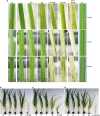Differential Synergistic Interactions Among Four Different Wheat-Infecting Viruses
- PMID: 35095810
- PMCID: PMC8793356
- DOI: 10.3389/fmicb.2021.800318
Differential Synergistic Interactions Among Four Different Wheat-Infecting Viruses
Abstract
Field-grown wheat (Triticum aestivum L.) plants can be co-infected by multiple viruses, including wheat streak mosaic virus (WSMV), Triticum mosaic virus (TriMV), brome mosaic virus (BMV), and barley stripe mosaic virus (BSMV). These viruses belong to four different genera in three different families and are, hence, genetically divergent. However, the impact of potential co-infections with two, three, or all four of them on the viruses themselves, as well as the wheat host, has yet to be examined. This study examined bi-, tri-, and quadripartite interactions among these viruses in wheat for disease development and accumulation of viral genomic RNAs, in comparison with single virus infections. Co-infection of wheat by BMV and BSMV resulted in BMV-like symptoms with a drastic reduction in BSMV genomic RNA copies and coat protein accumulation, suggesting an antagonism-like effect exerted by BMV toward BSMV. However, co-infection of either BMV or BSMV with WSMV or TriMV led to more severe disease than singly infected wheat, but with a decrease or no significant change in titers of interacting viruses in the presence of BMV or BSMV, respectively. These results were in stark contrast with exacerbated disease phenotype accompanied with enhanced virus titers caused by WSMV and TriMV co-infection. Co-infection of wheat by WSMV, TriMV, and BMV or BSMV resulted in enhanced synergistic disease accompanied by increased accumulation of TriMV and BMV but not WSMV or BSMV. Quadripartite interactions in co-infected wheat by all four viruses resulted in very severe disease synergism, leading to the death of the most infected plants, but paradoxically, a drastic reduction in BSMV titer. Our results indicate that interactions among different viruses infecting the same plant host are more complex than previously thought, do not always entail increases in virus titers, and likely involve multiple mechanisms. These findings lay the foundation for additional mechanistic dissections of synergistic interactions among unrelated plant viruses.
Keywords: Triticum mosaic virus; barley stripe mosaic virus; brome mosaic virus; co-infection; synergistic interaction; virus–virus interaction; wheat; wheat streak mosaic virus.
Copyright © 2022 Tatineni, Alexander and Qu.
Conflict of interest statement
The authors declare that the research was conducted in the absence of any commercial or financial relationships that could be construed as a potential conflict of interest.
Figures






Similar articles
-
Plant Viral Synergism: Co-expression of P1 and NIaPro Cistrons of Wheat Streak Mosaic Virus and Triticum Mosaic Virus Is Required for Synergistic Interaction in Wheat.Mol Plant Microbe Interact. 2025 Mar;38(2):328-343. doi: 10.1094/MPMI-10-24-0126-FI. Epub 2025 Feb 12. Mol Plant Microbe Interact. 2025. PMID: 39536297
-
Asymmetry in Synergistic Interaction Between Wheat streak mosaic virus and Triticum mosaic virus in Wheat.Mol Plant Microbe Interact. 2019 Mar;32(3):336-350. doi: 10.1094/MPMI-07-18-0189-R. Epub 2019 Feb 11. Mol Plant Microbe Interact. 2019. PMID: 30106671
-
Synergistic interaction between wheat streak mosaic virus and Triticum mosaic virus modulates wheat transcriptome to favor disease severity.Front Plant Sci. 2025 Jan 8;15:1504482. doi: 10.3389/fpls.2024.1504482. eCollection 2024. Front Plant Sci. 2025. PMID: 39845488 Free PMC article.
-
Triticum mosaic virus: An overview of biology, functional genomics, gene expression vector, and management strategies.Virology. 2025 Feb;603:110377. doi: 10.1016/j.virol.2024.110377. Epub 2024 Dec 24. Virology. 2025. PMID: 39729964 Review.
-
Genetics and mechanisms underlying transmission of Wheat streak mosaic virus by the wheat curl mite.Curr Opin Virol. 2018 Dec;33:47-54. doi: 10.1016/j.coviro.2018.07.012. Epub 2018 Aug 2. Curr Opin Virol. 2018. PMID: 30077887 Review.
Cited by
-
High-Throughput Oxford Nanopore Sequencing Unveils Complex Viral Population in Kansas Wheat: Implications for Sustainable Virus Management.Viruses. 2025 Jan 17;17(1):126. doi: 10.3390/v17010126. Viruses. 2025. PMID: 39861914 Free PMC article.
-
Brome mosaic virus detected in Kansas wheat co-infected with other common wheat viruses.Front Plant Sci. 2023 Mar 3;14:1096249. doi: 10.3389/fpls.2023.1096249. eCollection 2023. Front Plant Sci. 2023. PMID: 36938011 Free PMC article.
-
Characterization of three quantitative trait loci conferring robust resistance to wheat yellow mosaic virus in the wheat cultivar Shunyou.Theor Appl Genet. 2025 Aug 27;138(9):230. doi: 10.1007/s00122-025-05016-5. Theor Appl Genet. 2025. PMID: 40864267
-
High-Throughput Sequencing Identified Multiple Fig Viruses and Viroids Associated with Fig Mosaic Disease in Iraq.Plant Pathol J. 2024 Oct;40(5):486-497. doi: 10.5423/PPJ.OA.04.2024.0068. Epub 2024 Oct 1. Plant Pathol J. 2024. PMID: 39397303 Free PMC article.
-
Distribution of Wheat-Infecting Viruses and Genetic Variability of Wheat Streak Mosaic Virus and Barley Stripe Mosaic Virus in Kazakhstan.Viruses. 2024 Jan 8;16(1):96. doi: 10.3390/v16010096. Viruses. 2024. PMID: 38257796 Free PMC article.
References
-
- Brakke M. K. (1987). “Virus disease in wheat,” in Wheat and Wheat Improvement, 2nd Edn, ed. Heyne E. G. (Madison, WI: American Society of Agronomy, Crop Science Society of America, Soil Science Society of America; ), 585–603.
-
- Burrows M., Franc G., Rush C., Blunt T., Ito D., Kinzer K., et al. (2009). Occurrence of viruses in wheat in the great plains region, 2008. Plant Health Progress 7. 10.1094/PHP-2009-0706-01-RS [Epub ahead of print]. - DOI
LinkOut - more resources
Full Text Sources

